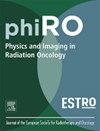A systematic review of tumour position reproducibility and stability in breath-hold for radiation therapy of the upper abdomen
IF 3.3
Q2 ONCOLOGY
引用次数: 0
Abstract
Background and purpose
Upper abdominal malignancies are relatively rare, and although surgery is considered the primary treatment option, radiation therapy has an emerging role in the management of liver, pancreas, kidney and adrenal gland tumours. Furthermore, stereotactic radiation therapy for the management of upper abdominal metastases is an expanding clinical indication. Breath-hold is one respiratory motion management strategy used in upper abdominal radiation therapy, and the reproducibility, and stability of breath-hold is critical for overall treatment accuracy.
Materials and methods
A systematic review of the literature was conducted in Medline, Embase and Cochrane databases with keyword and vocabulary terms related to radiation therapy, breath-hold and upper abdominal tumours.
Results
Following screening against the selection criteria, 41 studies were included. Breath-hold reproducibility was the most commonly reported outcome and exhale breath-hold was the most common type. Studies were either prospective or retrospective cohort studies, and the mean sample size was 19 participants. The risk of bias of each included study was assessed, and the mean quality assessment score for included studies was 90 % (77–100 %). Median exhale breath-hold cranio-caudal inter-fraction reproducibility was 0.6 mm, (IQR 0.3–1.6 mm), compared to inspiratory breath-hold 0.0 mm (IQR −0.6–2.97 mm). Stability measurements were ≤3 mm in 71 % of studies, irrespective of breath-hold type.
Discussion
Formulating institutional protocols for best clinical practice regarding breath-hold for upper abdominal tumours is challenging, given the significant variation in practices, interventions and definitions observed in the literature. Further investigation to individualise breath-hold strategies and safety margins is warranted.
上腹部放射治疗屏气时肿瘤位置的再现性和稳定性的系统综述
背景和目的上腹部恶性肿瘤相对罕见,尽管手术被认为是主要的治疗选择,但放射治疗在肝脏、胰腺、肾脏和肾上腺肿瘤的治疗中也起着新的作用。此外,立体定向放射治疗治疗上腹部转移性肿瘤是一个扩大的临床适应症。屏气是上腹部放射治疗中使用的一种呼吸运动管理策略,屏气的可重复性和稳定性对整体治疗的准确性至关重要。材料与方法在Medline、Embase和Cochrane数据库中对相关的放射治疗、屏气和上腹部肿瘤的关键词和词汇进行了系统的文献综述。结果根据筛选标准筛选,纳入41项研究。屏气重现是最常见的结果,呼气屏气是最常见的类型。研究为前瞻性或回顾性队列研究,平均样本量为19名参与者。对每个纳入研究的偏倚风险进行评估,纳入研究的平均质量评估评分为90%(77 - 100%)。呼气-屏气中位颅尾间隙重现性为0.6 mm (IQR为0.3-1.6 mm),吸气-屏气中位重现性为0.0 mm (IQR为−0.6 - 2.97 mm)。在71%的研究中,稳定性测量值≤3mm,与呼吸保持类型无关。考虑到文献中观察到的实践、干预和定义的显著差异,为上腹部肿瘤的屏气治疗制定最佳临床实践的制度方案是具有挑战性的。进一步调查个性化屏气策略和安全边际是必要的。
本文章由计算机程序翻译,如有差异,请以英文原文为准。
求助全文
约1分钟内获得全文
求助全文
来源期刊

Physics and Imaging in Radiation Oncology
Physics and Astronomy-Radiation
CiteScore
5.30
自引率
18.90%
发文量
93
审稿时长
6 weeks
 求助内容:
求助内容: 应助结果提醒方式:
应助结果提醒方式:


